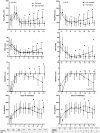Role of prognostic scores in predicting in-hospital mortality and failure of non-invasive ventilation in adults with COVID-19
- PMID: 35918627
- PMCID: PMC9345392
- DOI: 10.1007/s11739-022-03058-x
Role of prognostic scores in predicting in-hospital mortality and failure of non-invasive ventilation in adults with COVID-19
Abstract
We tested the prognostic performance of different scores for the identification of subjects with acute respiratory failure by COVID-19, at risk of in-hospital mortality and NIV failure. We conducted a retrospective study, in the Medical High-Dependency Unit of the University-Hospital Careggi. We included all subjects with COVID-19 and ARF requiring non-invasive ventilation (NIV) between March 2020 and January 2021. Clinical parameters, the HACOR score (Heart rate, Acidosis, Consciousness, Oxygenation, Respiratory Rate) and ROX index ((SpO2/FiO2)/respiratory rate) were collected 3 (-3) and 1 day (-1) before the NIV initiation, the first day of treatment (Day0) and after 1 (+1), 2 (+2), 5 (+5), 8 (+8) and 11 (+11) of treatment. The primary outcomes were in-hospital mortality and NIV failure. We included 135 subjects, mean age 69±13 years, 69% male. Patients, who needed mechanical ventilation, showed a higher HACOR score (Day0: 6 [5-7] vs 6 [6-7], p=.057; Day+2: 6 [6-6] vs 6 [4-6], p=.013) and a lower ROX index (Day0: 4.2±2.3 vs 5.1±2.3, p=.055; Day+2: 4.4±1.2.vs 5.5±1.3, p=.001) than those with successful NIV. An HACOR score >5 was more frequent among nonsurvivors (Day0: 82% vs 58%; Day2: 82% vs 48%, all p<0.01) and it was associated with in-hospital mortality (Day0: RR 5.88, 95%CI 2.01-17.22; Day2: RR 4.33, 95%CI 1.64-11.41) independent to age and Charlson index. In conclusion, in subjects treated with NIV for ARF caused by COVID19, respiratory parameters collected after the beginning of NIV allowed to identify those at risk of an adverse outcome. An HACOR score >5 was independently associated with increased mortality rate.
Keywords: COVID-19; Non-invasive ventilation; Prognosis; Respiratory failure.
© 2022. The Author(s).
Conflict of interest statement
No conflict of interest to declare.
Figures



Comment in
-
Hospital mortality and failure of non-invasive ventilation in COVID-19: looking inside the predictive scores.Intern Emerg Med. 2023 Mar;18(2):681-682. doi: 10.1007/s11739-022-03133-3. Epub 2022 Dec 21. Intern Emerg Med. 2023. PMID: 36542303 Free PMC article. No abstract available.
References
Publication types
MeSH terms
LinkOut - more resources
Full Text Sources
Medical

